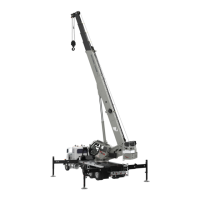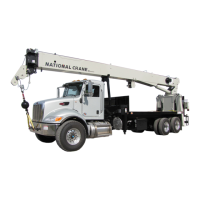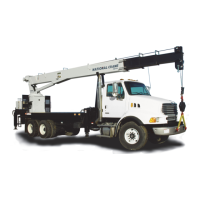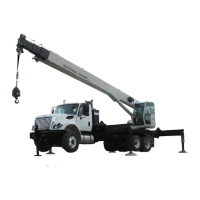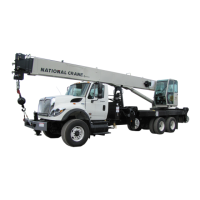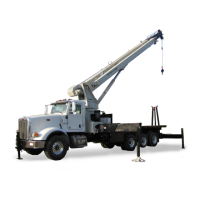NATIONAL CRANE Published 9-26-2018 Control # 646-02 2-29
NTC55 OPERATOR MANUAL SAFETY PRECAUTIONS
Tires
Inspect the tires for nicks, cuts, embedded material, and
abnormal wear.
Ensure all lug nuts are properly torqued.
Ensure pneumatic tires are inflated to the proper pressure.
When inflating tires, use a tire gauge, clip-on inflator, and
extension hose which will permit standing clear of the tire
while inflating.
HOIST ROPE
Synthetic Hoist Rope
For detailed information concerning synthetic hoist rope,
refer to K100™ Synthetic Crane Hoist Line Manual P/N
9828100734 available by contacting Manitowoc Crane Care.
During installation and setup, care must be taken to avoid
overlap and crossing of wire rope and synthetic hoist ropes.
Always make daily inspections of the hoist rope, keeping in
mind that all hoist rope will eventually deteriorate to a point
where it is no longer usable. Refuse to work with worn or
damaged hoist rope.
During regular inspections, operator shall ensure that crane
surfaces such as wear pads, sheaves, etc have not been
damaged in a manner that can then damage the synthetic
hoist rope.
Example; if usage of a wire rope has cut grooves with sharp
edges in a wear pad, they need to be addressed before the
synthetic hoist rope is used in that same position.
Wire Rope
Use only the rope specified by National Crane as indicated
on the crane’s Load Chart. Substitution of an alternate rope
may require the use of a different permissible line pull and,
therefore, require different reeving.
NOTE: Rope may be purchased by contacting Manitowoc
Crane Care.
Always make daily inspections of the rope, keeping in mind
that all rope will eventually deteriorate to a point where it is
no longer usable. Refuse to work with worn or damaged
rope. Rope shall be taken out of service when any of the
following conditions exist:
• For rotation-resistant running ropes: more than two (2)
broken wires in a length of rope equal to six (6) times the
rope diameter, or more than four (4) broken wires in a
length of rope equal to thirty (30) times the rope
diameter.
• For running ropes other than rotation resistant: six (6)
broken wires in one rope lay or three (3) broken wires in
one strand.
• One valley break where the wire fractures between
strands in a running rope is cause for removal.
• Abrasion of the rope resulting in a 5% reduction in the
original wire diameter.
• Any kinking, bird caging, crushing, corrosion, or other
damage resulting in distortion of the rope structure.
• Rope that has been in contact with a live power line or
has been used as a ground in an electric circuit (eg.
welding) may have wires that are fused or annealed and
must be removed from service.
• In standing ropes, more than three (3) breaks in one
rope lay in sections beyond the end connection or more
than two (2) broken wires at an end connection.
• Core deterioration, usually observed as a rapid
reduction in rope diameter, is cause for immediate
removal of the rope.
The following is a brief outline of the basic information
required to safely use wire rope.
• Wire ropes wear out. The strength of a rope begins to
decrease when the rope is put to use and continues to
decrease with each use. Rope will fail if worn-out,
overloaded, misused, damaged or improperly
maintained.
• The nominal strength, sometimes called catalog
strength, of a rope applies only to a new, unused rope.
• The nominal strength of a rope should be considered the
straight line pull which will actually break a new unused
rope. The nominal strength of a rope should never be
used as its working load.
• Each type of fitting attached to a rope has a specific
efficiency rating which can reduce the working load of
the rope assembly or rope system.
• Never overload a rope. This means never use the rope
where the load applied to it is greater than the working
load determined by the rope manufacturer.
WARNING
Possible equipment damage and/or
personal injury!
Driving the crane with a tire and split-rim assembly under
inflated at 80% or less of its recommended pressure can
cause the wheel and/or tire to fail. Per OSHA Standard
1910.177(f)(2), when a tire has been driven under inflated
at 80% or less of its recommended pressure, it must first
be completely deflated, removed from the axle,
disassembled, and inspected before re-inflation.
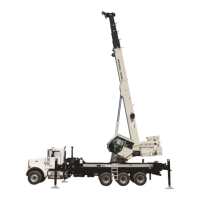
